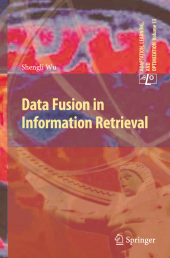 Neuerscheinungen 2014Stand: 2020-02-01 |
Schnellsuche
ISBN/Stichwort/Autor
|
Herderstraße 10
10625 Berlin
Tel.: 030 315 714 16
Fax 030 315 714 14
info@buchspektrum.de |

Shengli Wu
Data Fusion in Information Retrieval
2012. 2014. xii, 228 S. 235 mm
Verlag/Jahr: SPRINGER, BERLIN; SPRINGER 2014
ISBN: 3-642-44801-1 (3642448011)
Neue ISBN: 978-3-642-44801-0 (9783642448010)
Preis und Lieferzeit: Bitte klicken
This book offers a theoretical and empirical approach to data fusion, used in information retrieval in complex, diverse settings such as web and social networks, legal, enterprise and others. Discusses, analyzes and ealuates typical data fusion algorithms.
The technique of data fusion has been used extensively in information retrieval due to the complexity and diversity of tasks involved such as web and social networks, legal, enterprise, and many others. This book presents both a theoretical and empirical approach to data fusion. Several typical data fusion algorithms are discussed, analyzed and evaluated. A reader will find answers to the following questions, among others:
What are the key factors that affect the performance of data fusion algorithms significantly?
What conditions are favorable to data fusion algorithms?
CombSum and CombMNZ, which one is better? and why?
What is the rationale of using the linear combination method?
How can the best fusion option be found under any given circumstances?
Introduction.- Evaluation of Retrieval Results.- Score Normalization.- Observations and Analyses.- The Linear Combination Method.- A Geometric Framework for Data Fusion.- Ranking-Based Fusion.- Fusing Results from Overlapping Databases.- Application of the Data Fusion Technique.
From the reviews:
"This book is ... the result of a 10-year long engagement in data fusion within the context of various research projects. ... The book is written in a very concise and dense manner, which makes it ... readable for the expert, in particular the one with a good mathematical background. It contains a lot of evaluation results that help compare the various fusion methods presented, which is helpful for the practitioner. It also gives a good overview ... of applications of data fusion." (Gottfried Vossen, Zentralblatt MATH, Vol. 1246, 2012)


